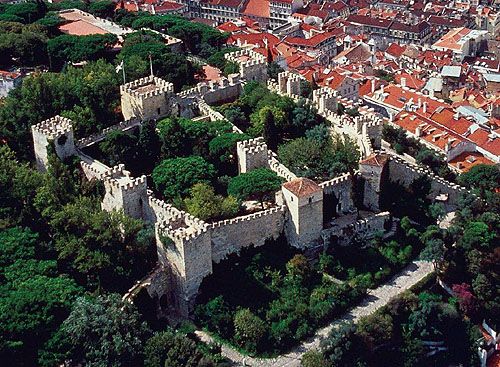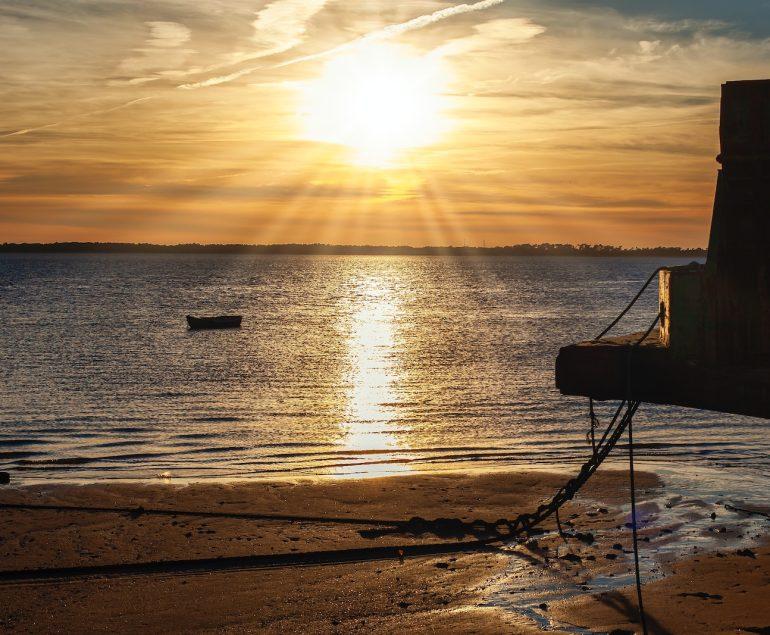Saint George’s Castle is visible from nearly every point in Lisbon city. Its earliest elements originate from the sixth century, when it was reinforced by the Romans, Visigoths, and, finally, the Moors. It was a royal Moorish residence until 1147, when Portugal’s first king, Afonso Henriques, seized it with the assistance of northern European crusaders on their route to the Holy Land. It was eventually consecrated to St. George, the patron saint of England, in commemoration of the Anglo-Portuguese treaty of 1371, and served as the royal residence until the 1755 earthquake destroyed it.

What remains of the Alcaçovas Palace, where medieval kings once resided, is a stone structure that currently houses a restaurant and, around the rear, a small archaeological museum housed in three underground rooms (including the one where Vasco da Gama was received by King Manuel in 1499, after his voyage to India).
The majority of the castle was damaged over the years, particularly after the Great Earthquake of 1755, but it still has a lengthy extension of walls and 18 towers that were reconstructed in the early twentieth century. Visitors can climb the towers and walk around the walls for the most stunning views of Lisbon (which confirms it as one of the most beautiful cities in the world), or rest in the gardens where peacocks, geese, and ducks parade around. The Câmara Escura, a periscope that projects sights from around the city, is housed in one of the castle’s inner towers, the Tower of Ulysses.

Castelo de São Jorge has eleven towers, the most notable of which are the Torre de Mensagem (Tower of the Keep), Torre do Haver ou do Tombo (Tower of Riches or Tumbling Tower), Torre do Paço (Tower of the Palace), Torre da Cisterna (Tower of the Cistern), and the Torre de So Lourenço (Tower of St. Lawrence), all of which are located on the hillside.
THE KEEP’S TOWER
This was the castle’s most important and sturdy tower, intended to withstand major attack and hence utilized as a privileged command post. The royal standard flag was flown here as a symbol of the vassalage of the alcade (Moorish mayor) or governor to whom the monarch had entrusted the castle’s defense and holding. In the 18th century, this tower housed Lisbon’s first geodesic observatory.
TUMBLING TOWER OR RICHES’ TOWER
It was known as the Torre do Haver, or Tower of Riches since it housed the royal treasure (revenue from taxes and royal rents). During King Fernando’s reign (1367-1383), it held the Royal Archives, and the most significant records of the realm were said to “crash” or “tombar” into it. As a result, the Torre do Tombo, or “Tumbling” Tower, is still used to refer to Portugal’s largest archive. The Royal Archives were housed in this tower, the Palace Tower, and other buildings abutting the castle that belonged to the Royal Palace until the earthquake of 1755. The Camera Obscura, which has been installed atop this tower since 1998, is a technology that allows you to thoroughly examine the attractions in Lisbon.
THE PALACE TOWER
It was given this name because of its proximity to the previous Royal Palace, to which it was most likely connected. During the time of King Afonso V, the African, in the 15th century, it adjoined a wing of the palace known as the “house of the lions,” which housed two lions. It also housed the Royal Archives in the mid-16th century.
THE CISTERN’S TOWER
It was so named because of its cistern, which was used to collect and store rainwater.
ST. LAWRENCE TOWER
The tower, which was built on a hillside, was linked to the castle by a protected passageway, a feature common in peninsular military construction from the Moorish period. This ensured secure access to a well-positioned outside the castle (although wells were typically built at the base of a tower) or quick access to the exterior in case of siege, escape, or reinforcements or supplies coming in.




